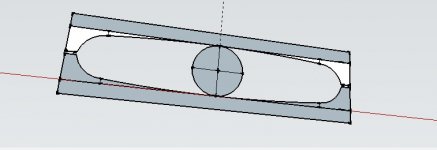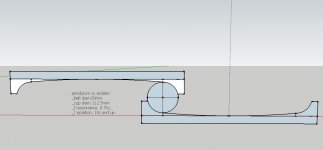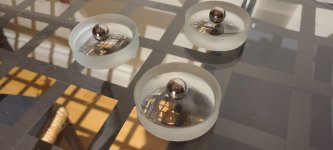It occurred to me that laboratory watch glasses have the right shallow curve and are highly polished glass, something like this:
Eisco Labs Watch Glass (Beaker Cover), 5cm, Pack of 12 : Amazon.co.uk: Business, Industry & Science
These are thin and would break under load by themselves, but could be cast into the top of a block of acrylic or epoxy resin fairly easily, so long as there's no air between the resin and the glass I think these would then be strong enough.
My set up is off line at the moment while I do some component upgrades so I won't be trying this myself any time soon, anyone else up for the experiment?
Eisco Labs Watch Glass (Beaker Cover), 5cm, Pack of 12 : Amazon.co.uk: Business, Industry & Science
These are thin and would break under load by themselves, but could be cast into the top of a block of acrylic or epoxy resin fairly easily, so long as there's no air between the resin and the glass I think these would then be strong enough.
My set up is off line at the moment while I do some component upgrades so I won't be trying this myself any time soon, anyone else up for the experiment?
I could be interested to try but not without knowing the exact curve used:
i constantly repeated it is of uttermost importance because it will set the overall efficiency of the decoupling and from my own experience with it over 1hz is too much compromise for me and the use i plan ( under loudspeakers ranging from 50kg to 10kg load).
It have another issue to me which is they are not wide enough. At least 10cm diameter under loudspeakers seems a minimum ( imo).
For the 'safety step' it could be dealt with, with your idea of epoxy/acrylic mould.
For components it might be ok though as i don't think that under 20hz there will be as much issues as with loudspeakers, even less if some other material ( like sorbothane or other 'metamaterial') is used in conjonction.
I will post some sketchup screen capture tonight to give a more visual approach of what i ended up with some years ago ( and how it could be produced) if it could help others.
But you got me interested nevertheless: it could make a nice platform under my Technics SL10!
i constantly repeated it is of uttermost importance because it will set the overall efficiency of the decoupling and from my own experience with it over 1hz is too much compromise for me and the use i plan ( under loudspeakers ranging from 50kg to 10kg load).
It have another issue to me which is they are not wide enough. At least 10cm diameter under loudspeakers seems a minimum ( imo).
For the 'safety step' it could be dealt with, with your idea of epoxy/acrylic mould.
For components it might be ok though as i don't think that under 20hz there will be as much issues as with loudspeakers, even less if some other material ( like sorbothane or other 'metamaterial') is used in conjonction.
I will post some sketchup screen capture tonight to give a more visual approach of what i ended up with some years ago ( and how it could be produced) if it could help others.
But you got me interested nevertheless: it could make a nice platform under my Technics SL10!
Last edited:
This sort of watch glass is usually well over 50mm in diameter, so getting some large enough for your speakers wouldn't be a problem. I'd be interested in any more information you have as to the type of curve required for the 1 Hz limit you have set for your project. I was more thinking along the lines of cheap and possibly effective without going into the maths!
Brakspear75,
Well it occured to me there was other diameter on offer on the link you gave!
I will take a look at them and see if it can be found cheaply in EU.
I'm not good at physics and math but... why bother when we have calculator for this!
Simple Pendulum Calculator
Use 1G ( the constant on earth) and the pendulum frequency you target it will gives you the radius you are looking for.
For 0.5hz it is in the 1m range ( a bit less 0.99 m).
As we are interested in very low angle of deplacement (<15°) the results are ok.
Well it occured to me there was other diameter on offer on the link you gave!
I will take a look at them and see if it can be found cheaply in EU.
I'm not good at physics and math but... why bother when we have calculator for this!
Simple Pendulum Calculator
Use 1G ( the constant on earth) and the pendulum frequency you target it will gives you the radius you are looking for.
For 0.5hz it is in the 1m range ( a bit less 0.99 m).
As we are interested in very low angle of deplacement (<15°) the results are ok.
Here is some pictures of an isolator with 0.7hz resonance 111.5mm diameter and a ball between 20mm and 22mm.
The radius is 0.507m (50.7cm) and there is the 'safety step' to limit displacement and be 'fall proof'.
My own experiments led me to this freq of 0,5/1hz but ymmv, and as already said nothing stop you to try the concept even non optimised on a cheap.
Having a custom one done would require a cnc lathe and a good polisher. Once one unit is done there is way to have them duplicated if you can find an 'art foundry'* working with 'lost wax' technique.
What will cost money in the duplication is the mould, but once done it can be repeated to infinite and in the dedicated material of your choice... from aluminium to mechanical bronze...
The radius is 0.507m (50.7cm) and there is the 'safety step' to limit displacement and be 'fall proof'.
My own experiments led me to this freq of 0,5/1hz but ymmv, and as already said nothing stop you to try the concept even non optimised on a cheap.
Having a custom one done would require a cnc lathe and a good polisher. Once one unit is done there is way to have them duplicated if you can find an 'art foundry'* working with 'lost wax' technique.
What will cost money in the duplication is the mould, but once done it can be repeated to infinite and in the dedicated material of your choice... from aluminium to mechanical bronze...
Attachments
Last edited:
It works yes. But at which frequency do you start to have isolation? Do you have a way to calculate it and then verify the efficiency ( verifying is not an issue anymore as every smartphone does have some vibration captors availlable and free seismic watching applications exist too).
My own experience is that it is way higher than what you could achieve using either air spring or the earthquake device ( within the 40 to 60hz, with dedicated materials used in acoustic builds you can expect low 30/high 20 but with a high load usually).
Does it make a difference? Try it as there is way to do it on the cheap and draw your own conclusion.
My own experience is that it is way higher than what you could achieve using either air spring or the earthquake device ( within the 40 to 60hz, with dedicated materials used in acoustic builds you can expect low 30/high 20 but with a high load usually).
Does it make a difference? Try it as there is way to do it on the cheap and draw your own conclusion.
- Home
- General Interest
- Room Acoustics & Mods
- Component Isolation


